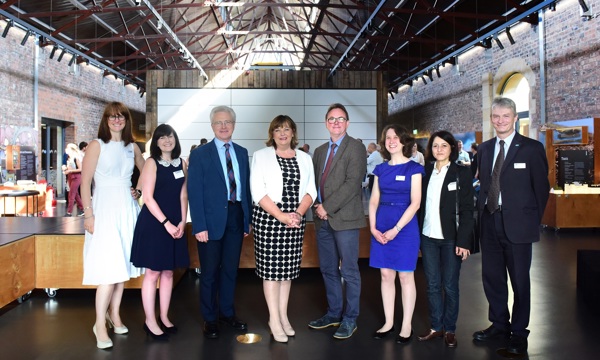A new partnership to harness space and satellite technology to protect Scotland’s historic sites from climate change has launched today (Friday 28 June).
Fiona Hyslop, Cabinet Secretary for Culture, Tourism, External Affairs and Europe, was in attendance as the project kicked off with an event at the Engine Shed in Stirling, co-organised by Historic Environment Scotland (HES), remote monitoring specialist Moniteye and European Space Agency (ESA) Business Applications and ESA Space Solutions.
Bringing together a range of partners from across the heritage sector, the project will explore the challenges faced in protecting historic sites from threats such as coastal erosion and ground movement, and how satellite capabilities can assist in monitoring and managing these impacts.
The project will build on the current use of innovative space and satellite techniques within heritage management. It will be using radar data from the Sentinel satellite to measure terrain movement and developing a methodology to apply this to heritage assets in Scotland for the first time.
The project will be focusing on specific case studies, including Skara Brae, part of the Heart of Neolithic Orkney World Heritage Site, and Mavisbank Policies, the area of designed landscape laid out in the early 18th century around Mavisbank House in Midlothian. Skara Brae is vulnerable to coastal erosion related to climate change, while Mavisbank Policies are affected by localised slope instability, which can be exacerbated by changes in rainfall patterns.
Mairi Davies, Climate Change Manager at HES, said:
We’re delighted to launch this exciting new project which will take a new and innovative approach to understanding and managing the climate change risk to Scotland’s historic sites.
“At HES, we are very much at the forefront of investigating and researching the historic environment and addressing the impacts of climate change on its future, and it is fitting to launch this project at the Engine Shed, our hub for digital and technological innovation.
“This project showcases the strength of the space sector in Scotland, with many organisations already using satellite data in range of innovative applications.
“This launch also highlights the importance of collaboration in facing the shared challenges presented by climate change, and we’re very pleased to welcome partners from across the sector to discuss some of the pioneering work taking place in this area.”
Culture Secretary Fiona Hyslop said:
“Historic Environment Scotland supports the Scottish Government in delivering our ambitious climate change targets, and is committed to identifying new ways that conservation can be maintained at its sites.
The satellite data used in this partnership with the European Space Agency is a fascinating example of how space technology can help preserve, monitor and manage change at our historic sites.”
Nick Appleyard, Head of European Space Agency (ESA) Business Applications, said:
“Space derived information and capabilities are an engine for sustainable new businesses. This project builds on successful development of services for asset and infrastructure condition monitoring, which was previously supported by ESA Business Applications.
"It will now introduce space to new user communities and customers who are concerned with ground motion and climate change impacts at internationally important cultural heritage sites."
Graeme Phipps Director at Moniteye, said:
“As a company specialising in remote monitoring, we have been assessing satellite capabilities for a number of years and are particularly excited about the information that can be derived from Synthetic Aperture Radar data.
"Assets close to the coastline present a number of different technical challenges when using satellite data. This project will hopefully address these issues and develop a satellite based monitoring solution for the benefit of HES and other asset owners.”
Speakers at the event included representatives from heritage, academic and research sectors including the Dynamic Coast project, which researches Scotland’s coastal change, and CHERISH, which aims to increase knowledge and understanding of the impacts of climate change on the cultural heritage of reefs, islands and headlands of the Welsh and Irish regional seas.
For more information about how HES is working to understand, manage and mitigate the impact of climate change on the historic environment, see our Climate Change pages.
Images © Julie Howden
About Historic Environment Scotland (HES)
- We are the lead public body charged with caring for, protecting and promoting the historic environment. We will lead on delivering Scotland’s first strategy for the historic environment, Our Place in Time.
- Historic Scotland, Scran, Canmore, The National Collection of Aerial Photography (NCAP), The Engine Shed, Stirling Castle and Edinburgh Castle are sub-brands of HES.
- View our press pack and keep up to date by registering for media release email alerts. If you wish to unsubscribe, please contact us.
Follow Historic Environment Scotland
Twitter: @HistEnvScot | @welovehistory
Facebook: @HistoricEnvScotland | @VisitHistoricScotland
Instagram: @HistEnvScot | @historicscotland
For further information, please contact:
Stacey Dent
Historic Environment Scotland Media Office
Direct line: 0131 668 8097
Mobile: 07557 489 322
communications@hes.scot

